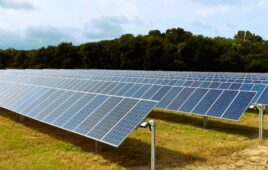Former Governors Arnold Schwarzenegger and Jerry Brown and other local elected officials joined local high school students, business leaders and workers, renewable energy advocates, and community leaders marked achieving one million solar roofs across California during a celebration event at Buchanan High School in Clovis.
In 2006, then-Governor Schwarzenegger signed the Million Solar Roofs Initiative into law, which set a goal of building one million solar energy systems on homes, schools, farms, and businesses throughout the state. In 2019, the idea that once made international headlines for its “wow factor” is now a reality.
“California is leading the way to a clean energy future,” said Former Governor Arnold Schwarzenegger. “13 years ago, we set a huge goal: to build a million solar roofs in our state by 2019. Republicans and Democrats came together behind a policy that would be successful years after we all left office — it wouldn’t be ready for our re-election campaigns — because we understood that big, worthwhile goals were more important than politics. Today, we celebrate the vision and the hardworking Californians that made a million solar roofs a reality.”
This is Troy. I met him today. He grew up in Bakersfield where he said the two job choices were agriculture or oil. He chose oil and worked his ass off drilling. But today he works in the solar industry, and he loves his job. I want everyone to hear his story. pic.twitter.com/qsDeJCYWuV
— Arnold (@Schwarzenegger) December 13, 2019
A new report, “1 Million Solar Roofs: A California Clean Energy Milestone,” released by the California Solar and Storage Association (CALSSA), provided a deeper look at the state’s solar success story. The report showed significant growth in unexpected places like the Central Valley where several cities that rank in the top tenth-percentile of California cities by the number of solar roofs are significantly outperforming their per-capita population rankings. Cities in the Sacramento and San Diego regions were also disproportionately strong markets for solar power.
The benefits of the Million Solar Roofs Initiative exceeded expectations. The initiative’s goal was to build 3 gigawatts of rooftop solar throughout the state. The program met its goal in 2015, ahead of schedule, and the market has continued to grow. Today, California consumers have installed nearly 9 gigawatts of local solar energy, three-fold the original goal, thanks to the successful transformation brought about by the Million Solar Roofs Initiative launched in 2006 with Senate Bill 1, authored by former state senator Kevin Murray (D-Culver City). Those 9 gigawatts of solar energy — the size equivalent of six large natural gas power plants — generate more than 13 billion kilowatt-hours of clean electricity each year avoiding 22 million tons of CO2, 16,000 tons of smog-forming pollutants, over 350 billion cubic feet of natural gas and bypassing expensive and aging utility infrastructure.
“We did it! We built a million solar homes, farms and schools,“ said Bernadette Del Chiaro, executive director of the California Solar and Storage Association. “Not long ago, solar energy had a reputation of being only for backwoods hippies and Malibu millionaires, but thanks to the vision of our leaders, the ingenuity of our business community, and a million forward-thinking consumers, we have transformed solar into a mainstream energy resource where everyone from low-income renters in San Diego to farmers in the San Joaquin Valley are making it an everyday household appliance.”
The Million Solar Roofs Initiative was also the catalyst for significant job growth in an industry that supports hundreds of local small businesses and over 77,000 jobs — more people than employed in the state’s five largest utilities combined. Solar jobs are found in every region of the state from Kern County to Crescent City.
As they celebrated the one million solar roofs milestone, solar advocates kept their focus on the future with a call for one million solar-charged batteries by 2025. With today’s batteries, homeowners and businesses can store solar energy for use after sundown or during a blackout. This smooths out prices, takes pressure off the electric grid, and gives consumers a degree of independence previously unheard of.
“Solar energy is one of the most impactful and tangible ways to solve climate change at scale and at speed,” said Dan Jacobson, state director of Environment California. “As we strive to meet the state’s 100% clean energy goals, we need solar energy and energy storage technologies on every available rooftop and in every available garage. We are off to the races with today’s celebration of building a million solar roofs but there’s no time to lose.”
During a celebration at Buchanan High School in Clovis, local students presented Governor Schwarzenegger with an award for his role as a champion for solar energy and climate activism. Governor Jerry Brown and Senator Kevin Murray were also presented with awards for their key roles in reaching this goal. Buchanan High School utilizes solar and storage for its operations and its Clean Energy Academy is educating the next generation of solar installers and designers.
News item from CALSSA





“Those 9 gigawatts of solar energy — the size equivalent of six large natural gas power plants — generate more than 13 billion kilowatt-hours of clean electricity each year avoiding 22 million tons of CO2, 16,000 tons of smog-forming pollutants, over 350 billion cubic feet of natural gas and bypassing expensive and aging utility infrastructure.”
The constant ‘war cry’ of ROI was entrenched into the minds of the ratepayers. With some “actual” experience by using the technology in one’s home or business every day, it has been proven the electric utility’s (allowed) business model of when you sell less electricity than you used to, then the utility has a “right” to recapture that cost claiming “lost revenues”. In some electric utility sphere’s of influence, electricity rates were fairly cheap. Those who chose to ‘pay it forward’ and install their own solar PV system had simple ROI periods of 20 years. When all was “said and done”, the utilities cried for lost revenues several times over the years and the (actual) ROI was 15 years for those early adopters. Every time one of these utilities pass on a loss to ratepayers, the ROI on one’s personal solar PV system goes down. In California with tiered electric use rates, TOU rate spiking and other sundry demand charges, people have been installing relatively large systems on their homes in the 10 to 15kWp peak size and have been paying for these systems in 5 to 7 years, with these roving electricity rates going from $0.17/kWh to $0.31/kWh during certain periods of the day. This with the PSPS is pushing those that buy into a system to not only put in solar PV and smart ESS technology to skip as much utility “program foolishness” during a typical day of energy use.
Not so much, “What’s the ROI”, on that system, the paradigm has shifted to “What’s the value” of having some energy available, since the local or regional utility cannot necessarily be trusted to supply reliable electricity as they once did.